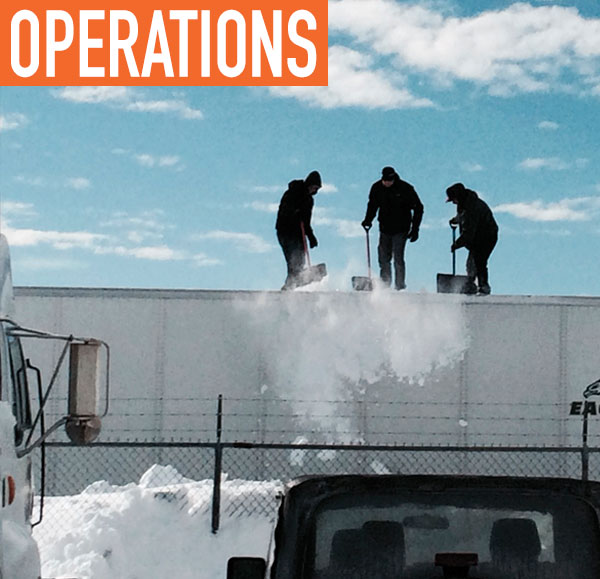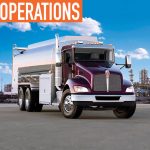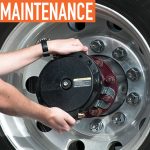Accumulated snow on the tops of tractor-trailers and trucks—or any vehicle in transit—is a significant safety concern and one that the trucking industry has been trying to address for years. In 2008, the American Transportation Research Institute (ATRI) conducted an extensive study of this winter-related issue for the trucking industry in North America. “The size and weight of ice sheets that may dislodge from larger vehicles in transit create a more significant safety concern for the trucking industry. Operational impacts from accumulated snow and ice are also possible, including size and weight limit violations and lowered fuel economy,” writes ATRI. “Removing snow and ice from the tops of trailers creates a series of safety and operational challenges.”
SAFETY AND REGULATION CHALLENGES
While those who are not in the trucking industry may believe that the best solution is to have either the truck driver or a maintenance employee ascend to the top of a truck or trailer to remove snow, this is a highly risky method of snow removal. Trailer/truck rooftops are extremely slippery surfaces which, combined with high elevations and adverse weather conditions, are dangerous for any person. “In many cases this practice violates federal or state worker safety guidelines,” according to ATRI.
The US Occupational Safety and Health Administration’s (OSHA) guidelines for worker safety dictates personal protection equipment (PPE) standards for workers who use raised platforms or catwalks to clear snow or ice from trailers. This standard applies to activities inside the facility or contiguous to a building or other structure where the installation of fall protection is feasible. OSHA’s General Duty Clause requires an employer to provide employees with a free of hazards workplace. “If OSHA is notified or an OSHA inspector witnesses a driver or any employee at a company facility climbing on top of a trailer without fall protection, the trucking company can be cited for violating the General Duty Clause,” notes ATRI.
With the continuation of harsh winters, we have seen an increase in state legislation, particularly in the Northeast, while some states simply rely on existing transportation legislation to detain and cite vehicles whose snow accumulation is deemed unsafe. They may use “loose load” or height/weight restriction or they may issue a citation for a violation if an incident occurs due to snow accumulation. Certain state highways, such as the Mass Pike, have additional rules to try to combat the issue.
In 2008, Canada’s efforts to address this safety issue were seen as more progressive than US efforts. For example Quebec has a regulation specifically prohibiting any vehicle operator from allowing snow and ice to fall from their vehicle. Now, some US states have also adopted this “all vehicle” regulation, such as Connecticut, who adopted the law in 2013.
PROVIDING A SOLUTION
ATRI’s report on the advantages and disadvantages of methods employed by companies in North America to try to combat snow accumulation—namely snow scrappers, throwers, truck washes, catwalks, and rolling ladders—led the team at TrucBush to explore a new solution. In 2012, the manager of a large Boston-based airfreight company for snow management hired the team. He tasked them with finding a method to manage the largest snow-related issue in the trucking industry—the safe and effective removal of snow from the tops of the company’s fleet.
Until then, the company’s employees had spent countless hours trying to clear the snow from the fleet of approximately 45 combined box trucks and tractor-trailers utilizing rolling ladders and manual labor. For the airfreight company, safety and lack of efficiency were primary concerns. The team at TrucBrush identified all the issues and brainstormed possible solutions with the freight-forwarding manager. The team knew that the new solution would need to be mobile and capable of being easily removed—both between storms and after winter season—as the airfreight company did not want a fixed system that would take up valuable space or be a potential hazard for a driver to back into. The solution would also have to be flexible enough to quickly and easily perform on various heights, while being safer for both employees and their trucks’ fiberglass rooftops. Finally, the solutions had to be quick.
The outcome of the team’s efforts and engineering was TrucBrush®—a patented, mobile, polypropylene-bristled broom device that brushes snow off the top of a truck or trailer in a minute or less. The device operates from the hydraulics of a front-end loader, a common piece of equipment utilized in snow management. It also has the ability to disconnect from the loader’s coupler to interchange it for a snow pusher or bucket when needed.
“The whole conversation came about from a selfish standpoint: I needed a solution to a problem. That Jim, president of TrucBrush, and his team were willing to take on an unknown concept and put the time in to become passionate, learn all they could, and design a solution was amazing,” the airfreight manager says. “Not only did he come up with a solution to remove the snow, he also outlined an entire safety protocol to manage the concept.”
FOR MORE INFORMATION:
Debora Babin Katz is vice president of TrucBrush Corporation based in South Easton, Massachusetts. She is committed to the trucking and snow maintenance industries as a volunteer to industry associations, as well as chair of the Editorial Advisory Committee of the national magazine Snow Business and chair of the Women in Trucking Foundation Board, which focuses on raising funds for scholarships to help forward women’s careers in the transportation industry. Reach Debora at dkatz@trucbrush.com.
_______________________________________________________________________
MODERN WORKTRUCK SOLUTIONS: FEBRUARY 2016 ISSUE
Did you enjoy this article?
Subscribe to the FREE Digital Edition of Modern WorkTruck Solutions magazine.
![]()




